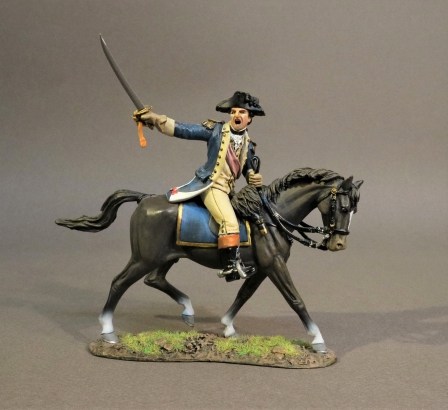
THE EIGHTEENTH CENTURY COLLECTION
DRUMS ALONG THE MOHAWK

SGEN-02
The Battle of Saratoga 1777, Continental Army,
Major General Benedict Arnold
(2pcs) US$98
"The surrender that changed the world"
In October 1777, a 6,000 strong British army surrendered
in defeat after the American victory at the Battles of Saratoga.
For the first time in history a British General surrendered his sword
The German mercenaries were firing steadily from their redoubt.
From the rear came the crack of rifles.
A general mounted and, his sword flashing, led the riflemen into the redoubt.
German resistance collapsed. The Battle of Saratoga was over.
The day was Oct. 7th, 1777.
Twelve days later, "Gentleman Johnny"Burgoyne, the gifted,
courageous British commander,
surrendered to the American general, Horatio Gates.
Thus ended the most
ambitious and dangerous offensive launched
by Britain in the Revolution.
The attack on the redoubt was the last of a series of actions
that constituted the Battle of Saratoga,
considered the turning point of the Revolution.
The rifle fire that decimated the Germans awoke echoes around the World.
The French court,
friendly to any who fought their ancient British enemy,
finally was convinced that France's interest
lay in entering the war on the side of the Americans.
Following intense fighting with the Continental Army in September,
the British Army fortified themselves behind two defensive redoubts- the larger,
better defended Balcarres Redoubt,
and the weaker
Breymann Redoubt.
American forces, led by General Benedict Arnold,
managed to take the Breymann Redoubt,
which gave them a strong position behind the British lines.
The loss of the Redoubt rendered the British position untenable.
The British Army was forced to pull back to the river,
from which position they would attempt to retreat north the next morning.
The Continental Army was formed by the Second Continental Congress after the outbreak of
the American Revolutionary War by the colonies that became the United States of America.
Established by a resolution of the Congress on June 14, 1775,
it was created to coordinate the military efforts of the Thirteen Colonies in their revolt against the rule of Great Britain.
The Continental Army was supplemented by local militias
and troops that remained under control of the individual states or were otherwise independent.
General George Washington was the commander-in-chief of the army throughout the war.
The Continental Army consisted of soldiers from all 13 colonies and,
after 1776, from all 13 states.
When the American Revolutionary War began at the Battles of Lexington and Concord on April 19,
1775, the colonial revolutionaries did not have an army.
Previously, each colony had relied upon the militia,
made up of part-time citizen-soldiers,
for local defense, or the raising of temporary "provincial regiments"
during specific crises such as the French and Indian War of 1754-63.
As tensions with Great Britain increased in the years leading to the war,
colonists began to reform their militias in preparation for the perceived potential conflict.
Training of militiamen increased after the passage of the Intolerable Acts in 1774.
Colonists such as Richard Henry Lee proposed forming a national militia force,
but the‚ First Continental Congress rejected the idea.
The Continental Army of 1777-80 evolved out of several critical
reforms and political decisions that came about when it became apparent
that the British were sending massive forces to put an end to the American Revolution.
The Continental Congress passed the "Eighty-eight Battalion Resolve",
ordering each state to contribute one-battalion regiments in proportion to their population,
and Washington subsequently received authority to raise an additional 16 battalions.
Enlistment terms extended to three years or to "the length of the war"
to avoid the year-end crises that depleted forces (including the notable near-collapse of the army at the end of 1776,
which could have ended the war in a Continental, or American, loss by forfeit).
Three of the Continental Army units which took part in the assault on the Breymann Redoubt,
were the 2nd Massachussetts, The 2nd New York, and The 1st Canadian Regiment.
Major General Benedict Arnold (1741-1801)
Benedict Arnold was an American military officer who served as a general
during the American Revolutionary War,
fighting for the American Continental Army before defecting to the British in 1780.
Arnold was born in the Connecticut Colony and was a merchant operating ships
on the Atlantic Ocean when the war began in 1775.
He joined the growing army outside Boston and distinguished
himself through acts of intelligence and bravery.
His actions included the Capture of Fort Ticonderoga in 1775,
defensive and delaying tactics at the Battle of Valcour Island on Lake Champlain
in 1776 which allowed American forces time to prepare New York's defenses,
the Battle of Ridgefield, Connecticut (after which he was promoted to major general),
and operations in relief of the Siege of Fort Stanwix.
We now accept PAYPAL,
to purchase your figures please send your order by e-mail to
inquiry@johnjenkinsdesigns.com
after checking that everything is available,
you will be billed via PAYPAL.
your order will be shipped on confirmation of payment.
worldwide airmail 15%
(minimum postage us$15)
JOHN JENKINS DESIGNS
UNIT 6E, TOWER 2,
KING LEY INDUSTRIAL BUILDING,
33-35 YIP KAN STREET,
WONG CHUK HANG,
HONG KONG
Tel: 852 9041 9065